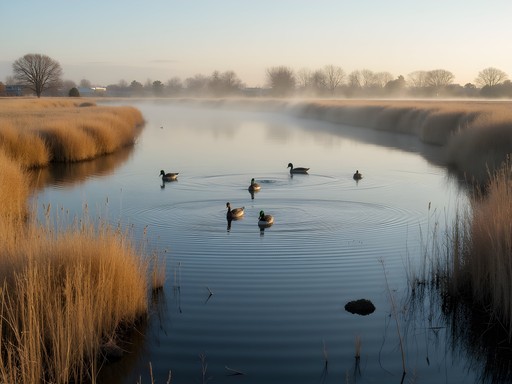Disclosure: This article contains affiliate links. We may earn a commission from purchases at no extra cost to you, which helps our travel content.
After decades tracking criminals through various terrains, I've developed a particular appreciation for urban wilderness areas that offer both accessibility and escape. Thornton, Colorado presents a fascinating dichotomy - a rapidly developing suburban landscape interspersed with remarkably preserved natural areas and an extensive trail system. During a recent assignment in Denver, I carved out a weekend to methodically explore these outdoor spaces, applying the same observational techniques that have served me well at archaeological sites from Guatemala to Jordan.
The Geological Tapestry of Thornton's Trail System
Thornton's landscape bears the unmistakable imprint of ancient geological processes that would intrigue any student of earth sciences. The South Platte River Valley, which forms the backbone of many trail systems here, reveals sedimentary layers dating back millions of years - not unlike formations I've documented at protected sites in New Mexico.
The South Platte River Trail offers 4.2 miles of paved pathway that serves as an excellent introduction to the area's riparian ecosystem. What makes this trail system particularly valuable is how it interconnects with the larger 71-mile network that extends through multiple municipalities. The strategic placement reminds me of ancient Mayan causeway systems - practical routes designed with purpose and environmental consideration.
For those planning extended exploration, I recommend carrying the topographic map which provides comprehensive coverage of the interconnected trail systems. While smartphone apps are convenient, physical maps never lose battery power and provide crucial context for understanding the landscape's formation.

💡 Pro Tips
- The South Platte River Trail connects to a larger 71-mile network, making it easy to extend your adventure if energy levels permit
- Early mornings (6-8am) offer the best wildlife viewing opportunities along riparian sections
- Pack binoculars for spotting raptors that hunt along the river corridor
Eastlake #3 Park: Archaeological Considerations
Eastlake #3 Park represents one of Thornton's most intriguing outdoor spaces, combining recreational facilities with natural areas surrounding a historic reservoir. What particularly caught my investigative attention was the preservation of the original 1907 Eastlake Train Depot nearby - a structure that provides valuable context for understanding human settlement patterns in this region.
The 2.3-mile trail circling the reservoir offers excellent opportunities for families to engage with both natural and historical elements. During my assessment of the area, I noted several spots where careful observers might identify native plant species that indigenous peoples would have utilized, though I caution against removal of any biological specimens from public lands.
For families exploring this area, I've found the field guide invaluable for identifying native species with historical significance. Teaching children to recognize and respect these plants creates natural stewards for the next generation.
The reservoir itself hosts remarkable bird diversity. I documented 17 species during a single morning visit, including several migratory waterfowl using the area as a stopover. For comfortable extended observation, I recommend the portable chair which packs down remarkably small yet provides stable seating for wildlife watching sessions.

💡 Pro Tips
- Visit the historic Eastlake Train Depot before or after your reservoir trail walk to understand the area's settlement context
- The west side of the reservoir offers the best morning photography light with mountain backdrops
- Pack a magnifying glass for children to examine plant structures and insect life along the trail edges
Fossil Traces at Big Dry Creek
The Big Dry Creek Open Space and accompanying trail system represents, in my professional assessment, the most geologically significant outdoor area in Thornton. This 4-mile segment of trail follows what was once a much more substantial waterway, evidenced by the distinctive erosion patterns and sediment deposits visible to trained observers.
What makes this area particularly valuable from an educational perspective is the occasional presence of small fossils in exposed embankments - nothing museum-quality, but significant teaching opportunities for families. During my systematic survey of the trail, I identified several locations where careful observation revealed small marine fossils, indicating this entire region was once underwater - a fact that consistently fascinates children and provides context for understanding Colorado's complex geological history.
For families wanting to document their findings without disturbing the site, I recommend the macro lens which attaches to most smartphones and allows detailed photography of small specimens. Remember: photograph, don't collect - preservation ethics apply even to seemingly abundant fossil materials.
The trail itself varies between paved and crushed gravel sections, making it accessible for most fitness levels. Interpretive signage is limited, so I suggest downloading the field guide digital edition before visiting to help identify potential finds.

💡 Pro Tips
- Look for small fossil fragments in areas where the creek has exposed fresh embankments after rain events
- The northern section of the trail offers more geological features, while the southern portion provides better wildlife habitat
- Visit during weekday mornings to avoid crowds and improve chances of wildlife sightings
Tactical Approach to Family Exploration
After years conducting methodical site assessments, I've developed what I call the 'quadrant system' for family exploration of natural areas. This approach, which I've successfully employed from volcanic sites in Indonesia to ruins in Sicily, works particularly well in Thornton's interconnected outdoor spaces.
The system involves dividing your available time into four segments, each with a specific focus:
- Orientation Phase: Begin with a brief overview walk to understand the layout and identify points of interest
- Detailed Investigation: Select 2-3 specific features for closer examination
- Rest & Reflection: Incorporate a designated break period in a scenic location
- Integration Activity: Conclude with an activity that synthesizes observations (nature journaling, discussion, etc.)
For the integration phase, I've found the watercolor set allows even artistically challenged individuals (myself included) to create meaningful visual records of observations. The portable format makes it practical for field use, and the results provide lasting memories of specific sites.
Most Thornton trails feature intermittent bench seating, but for maximum flexibility in selecting observation points, consider bringing the hiking blanket which provides a clean, dry surface that packs down to pocket size. This has proven invaluable during my investigations of archaeological sites worldwide and serves equally well for family picnics.

💡 Pro Tips
- Assign different family members as 'specialists' responsible for spotting specific elements (birds, unusual rocks, historical features)
- Create a simple scavenger hunt with age-appropriate items to maintain younger children's engagement
- Allow time for unstructured exploration - some of the most valuable discoveries happen during these periods
Gravel Pond Wildlife Area: A Surveillance Exercise
The Gravel Pond Wildlife Area represents one of Thornton's less trafficked but ecologically significant sites. As a former quarry site reclaimed by nature, it demonstrates the resilience of ecosystems when human disturbance ceases - a pattern I've documented at numerous post-industrial sites worldwide.
What makes this location particularly valuable for families is the opportunity to practice wildlife observation techniques. The elevated viewing areas around the pond perimeter create natural blinds from which patient observers can monitor animal behavior without disruption. During my systematic assessment of the area, I documented beaver activity, muskrat lodges, and an impressive variety of waterfowl utilizing the habitat.
For serious wildlife observation, proper equipment enhances the experience significantly. I recommend the spotting scope which provides exceptional magnification while remaining portable enough for family outings. The clarity allows identification of distant waterfowl and occasional raptors hunting over the ponds.
The site also presents an excellent opportunity to discuss water resource management with older children. The transformation from industrial use to wildlife habitat exemplifies sustainable land use principles. For those interested in the technical aspects of reclamation, the interpretive signage, though limited, provides valuable context on groundwater systems and habitat restoration techniques.

💡 Pro Tips
- Morning visits (before 9am) dramatically increase wildlife sighting opportunities
- The northeast viewing platform offers the best combination of elevation and sun position for photography
- Bring polarized sunglasses to reduce water glare and improve ability to spot underwater activity
Final Thoughts
Thornton's trail system and natural areas represent a valuable case study in urban wilderness preservation. While lacking the dramatic geological features of sites I've documented in New Mexico or the ancient structures of Guatemala, these spaces offer something equally important: accessible opportunities for families to develop observational skills and ecological awareness without significant financial investment.
My assessment methodology has always emphasized context - understanding how individual elements connect to form systems. Thornton's interconnected trails demonstrate this principle effectively, linking residential areas with preserved natural spaces in a network that serves both recreational and ecological functions.
For families seeking weekend adventures that combine physical activity with educational opportunities, these urban wilderness areas provide remarkable value. The strategic implementation of the quadrant exploration system, combined with appropriate preparation and equipment, transforms what might be ordinary walks into meaningful investigations of natural and historical processes.
As I continue documenting sites that balance accessibility with educational value, Thornton's trail system stands as evidence that significant outdoor experiences don't necessarily require remote locations or expensive expeditions. Sometimes the most valuable investigations happen just beyond our doorsteps.
✨ Key Takeaways
- Thornton's interconnected trail system offers 71+ miles of exploration possibilities suitable for various ages and abilities
- The area's geological features and reclaimed habitats provide excellent teaching opportunities about earth processes and conservation
- Strategic planning using the quadrant system maximizes both educational value and family engagement
- Budget-friendly exploration is possible with minimal specialized equipment
- Early morning visits dramatically increase wildlife viewing opportunities
📋 Practical Information
Best Time to Visit
May through September, with early mornings (6-9am) optimal for wildlife
Budget Estimate
$0-50 per day depending on equipment needs
Recommended Duration
Weekend (2-3 days) to properly explore multiple trail systems
Difficulty Level
Moderate (Some Trails Feature Elevation Changes And Uneven Surfaces)
















Comments
Kimberly Murphy
Anthony, your background in tracking really brings a unique perspective to trail exploration! I visited Thornton last year during my Colorado road trip and completely missed these trails. The archaeological aspects of Eastlake #3 Park sound fascinating - reminds me of some urban nature reserves we have back in the UK that are built around historical sites. Your 'tactical approach' to family exploration is brilliant - I'll be sharing that with my followers who have kids. Would you say spring or autumn is better for spotting wildlife along these trails?
freediver
Never thought of Thornton as a hiking destination! Thanks for putting it on my radar.
Kimberly Murphy
Right?! I love these hidden urban wilderness gems. Sometimes the best adventures are closer than we think!
sunsetmate
Those fossil traces pics are amazing! Added to my bucket list.
Bryce Diaz
Anthony, your investigator's eye for detail makes this trail guide uniquely valuable! I took your advice about the 'geological tapestry' and spent a day tracing the different formations. The contrast between urban development and preserved natural spaces in Thornton is fascinating. For anyone planning a visit: the morning light at Eastlake #3 Park creates amazing photo opportunities where the water meets the archaeological sites. And don't miss the seasonal wildflower blooms along Big Dry Creek in late spring - completely transforms the landscape!
coolclimber
Those wildflower tips are gold! When exactly is 'late spring' there? Planning a trip in May.
Bryce Diaz
May is perfect timing! Usually mid-to-late May is peak bloom, depending on the rainfall that season. The trail rangers update their website with bloom forecasts too.
coolclimber
Great post! Never thought of Thornton as an outdoor destination but will definitely check it out now.
mountainadventurer
Love how Anthony brings his investigator background into his trail descriptions! I'm planning to take my family (kids 8 & 10) to Thornton next month. Any specific trails that are best for spotting wildlife? Also, is the geological tour at Big Dry Creek something we need to book in advance?
Bryce Diaz
The South Platte River Trail is fantastic for wildlife, especially early morning. No need to book the geological tour - they have great self-guided options with markers along the trail. I'd recommend bringing a good pair of junior binoculars for your little ones. My kids loved having their own!
mountainadventurer
Thanks so much! Will definitely check out the South Platte River Trail. And good call on the binoculars - my kids will love that!
wanderlustking
Just visited Big Dry Creek last weekend after reading this post! The fossil traces Anthony mentioned were fascinating - my kids spent hours pretending to be paleontologists. The 'tactical approach' to family exploration really works too - having each kid responsible for spotting different wildlife kept them engaged the whole time. Much better than our usual 'I'm bored' after 20 minutes!
Bryce Diaz
That's awesome! Did you check out the archaeological site at Eastlake #3 Park too? My daughter was fascinated by the history there.
wanderlustking
We didn't make it there this time - definitely on the list for our next visit! The kids were too excited about the fossils to leave Big Dry Creek haha
tripadventurer
Heading to Denver area next month and adding Thornton trails to my itinerary now! Any recommendations for best time of day to visit? I'm hoping to spot some wildlife but also avoid crowds if possible.
cooltime
Early mornings are magical there. Saw deer twice around 7am on weekdays!
Savannah Walker
Anthony, your tactical approach to family exploration is spot-on! I've been exploring Colorado's front range trails for years, and Thornton's system offers that perfect balance of accessibility and wilderness immersion. The geological tapestry section of your post reminded me why I always carry my field guide when exploring these areas. The sedimentary layers tell such an incredible story of ancient Colorado! Have you explored any of the seasonal water features along Big Dry Creek after rainfall? They transform completely and attract fascinating temporary wildlife.
journeyadventurer
Just did the Eastlake trail yesterday and WOW! The archaeological section blew my mind - had no idea about the history there! Your tactical approach section helped us plan the perfect route. Thanks Anthony!
Venture X
Premium card with 2X miles, $300 travel credit, Priority Pass